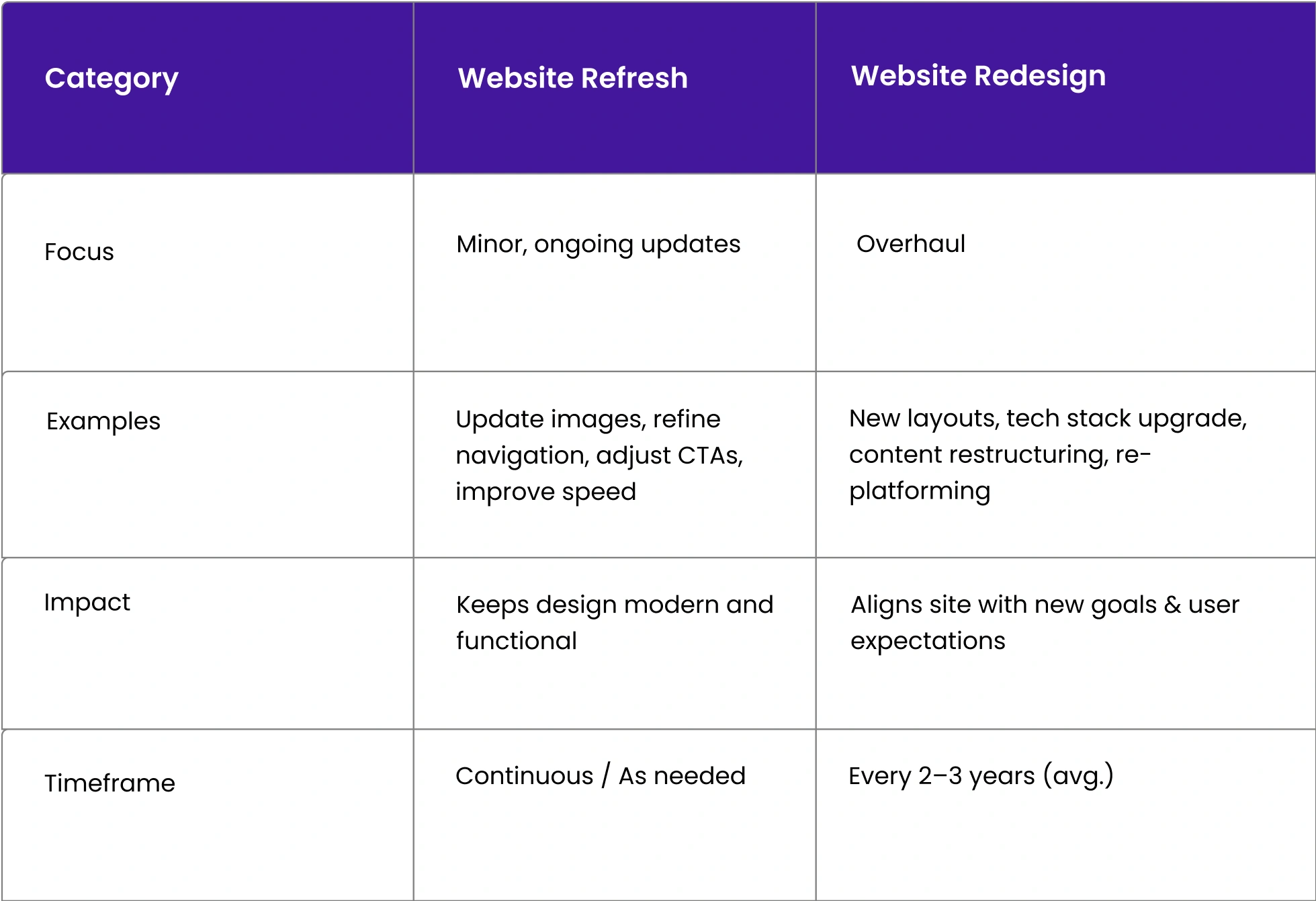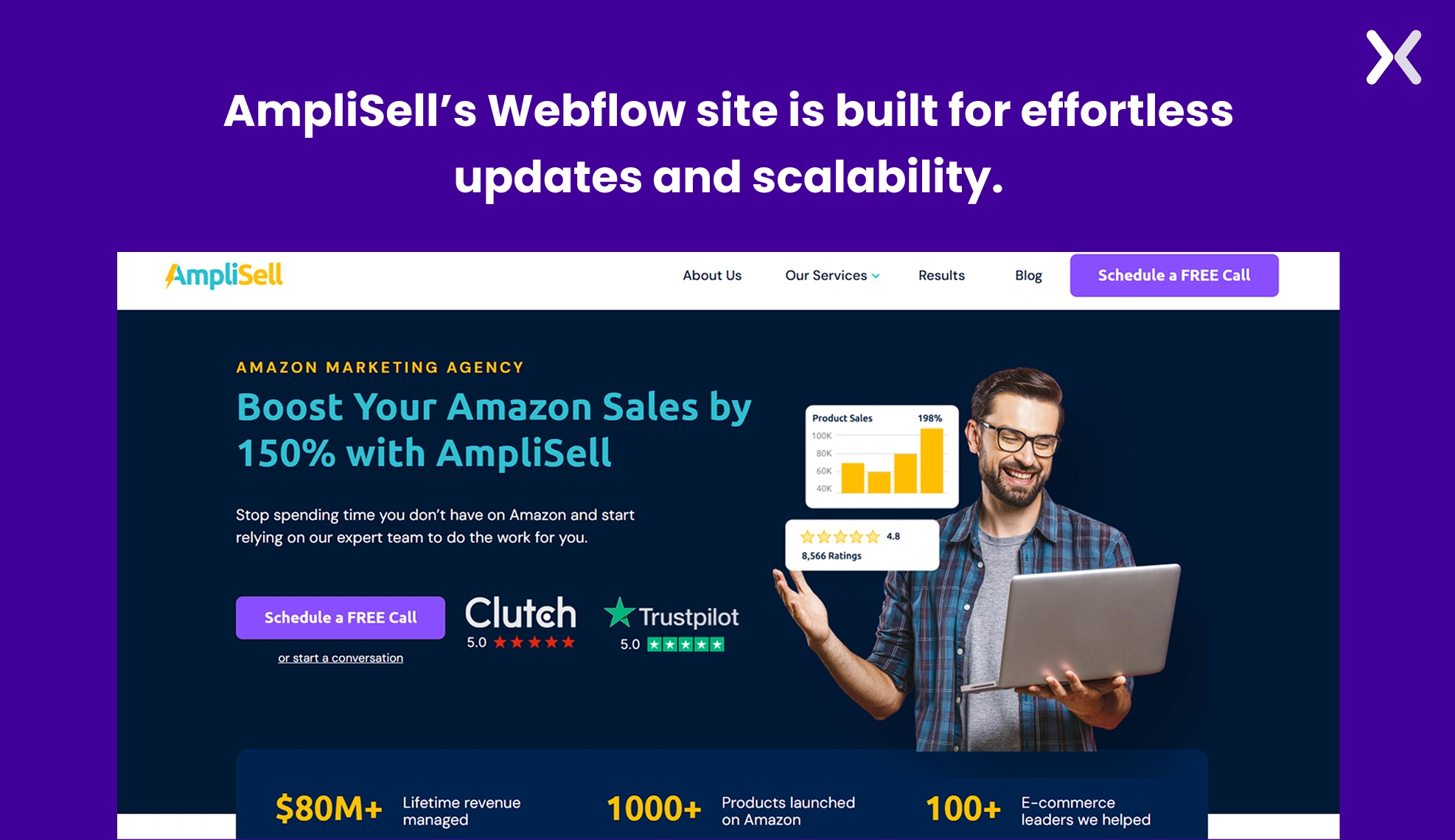A website redesign talk only happens when a business sees a major conversion drop. Suddenly, a website stops pulling its weight, bounce rates climb, and it feels like visitors’ interest has changed overnight.
The tricky part? It is hard to know if small tweaks will fix the problem, or if your site needs a complete redesign.
Such uncertainty is what makes website design such a pain point for businesses. Website redesigning too early can mean a waste of time and money, whereas redesigning too late means loss of leads. The challenge is figuring out the right moment to act.
This post will help you determine the key early signs to watch for to decide the right time for your website redesign.
Many industry researchers recommend that companies review the need for a website redesign every two to three years. It helps businesses stay aligned with the latest design trends, technological advancements, and new visitor behaviors. Such proactiveness allows companies to improve usability continuously and maintain a competitive edge.
HubSpot: 71% of marketing leaders report redesigning their websites every one to three years.
Huemor: The average lifespan of a website is about 2 years and 4 months. By industry, agencies typically redesign every 1 year and 8 months, beauty brands every 1 year and 7 months, while construction companies wait around 5 years and 5 months between redesigns.
But a two or three-year guideline is not a one-size-fits-all solution. The optimal website redesign frequency depends on business goals, industry context, and evolving expectations of your audience.
It becomes crucial to monitor the performance of your website and user activity regularly to catch the early signs of your website needing a redesign. By staying sensitive to these variables, you can ensure your website remains a powerful asset for conversion and customer retention.
Low conversion rates might not always mean that you need to fully revamp your website. Sometimes, small design tweaks can work too. Website refresh involves small updates to your website where you do small-scale A/B testing, like adjusting CTA or changing hero images. Whereas a website design involves rethinking layouts, upgrading the tech stack, or changing platforms (like moving from WordPress to Webflow).

How to decide: If your site feels generally fine but engagement is slipping, a refresh may be enough. But if website conversions are tanking, the design looks outdated, or your business has evolved beyond what your site represents, it’s time for a redesign.
Let’s look into the key signs that say your website needs a redesign.
A visible decline in key performance indicators like conversion rates, higher bounce rates, or lower user engagement usually indicates that your website might no longer be fulfilling user expectations. For example, if users are spending less time on your website or viewing fewer pages per visit, it might mean that the content or design is not engaging. Tracking these metrics is important to identify when it is time to redesign your website.
An outdated web design can be detrimental to the perception and functionality of the users. Research estimates that the design life of a website is about 2 years and 7 months, reinforcing the necessity to keep up with design trends. Moreover, considering that most global web traffic comes from mobile, it becomes crucial that your site is responsive to mobile devices. If you’re wondering how often you should redesign your website, analyzing accessibility on mobile devices might be an indicator.
How often should you redesign your website to achieve business objectives? With your business expanding, so too should your website. Product, service, target market, or marketing strategy changes mean that your online presence needs to be adapted to represent these changes in a way that is accurate and effective. Synchronizing your website with today’s business goals ensures that your site is maximizing support for your goals and carrying your message to your target market.
User feedback and behavior analysis are worth their weight in detecting design faults. Steep bounce rates, short time on site, or user reports of navigation problems can signal areas that need fixing. Continual user behavior analysis can aid in knowing how often you should update your website content to better satisfy and serve the user.
While keeping your website fresh is important, too many redesigns can mean resource outlays and possible user experience disruption. It’s imperative to weigh “website redesign frequency” against business requirements, having redesign choices guided by data and strategic intent. A planned redesign can enhance search engine positioning and user interaction, positively impacting your business.
In summary, knowing “how often should you redesign your website” means assessing performance metrics, keeping up with design trends, being in sync with business objectives, and taking into account user feedback. By planning redesigns strategically, you can optimize user experience and accomplish your business goals effectively.
If a website redesign looks a bit too much, you can always start small with the following alternatives.
Not all website problems demand a full revamp. Periodic, incremental changes keep a site up-to-date without breaking user experience. Updating navigation, optimizing CTA buttons, or enhancing mobile responsiveness can make a big difference in engagement and conversions. Studies indicate that even small design adjustments can enhance conversion rates by as much as 200%. Periodically fine-tuning your site is sufficient to keep it relevant, and not how often you should redesign your website.
A/B testing is an effective means of ascertaining which alterations will have a positive influence on user experience. Rather than effectuating sweeping changes, companies can try one aspect at a time, e.g., headlines, colors, or page layout, to receive data-driven feedback. This approach offers incremental website optimization, with improvements tied to website redesign frequency best practices. Firms leveraging A/B testing enjoy a 49% boost in average conversion rates.
An outdated website is not only about design. It is also about stale content. Blog updating, product descriptions revision, and landing page revisions are some effective methods for staying relevant. A well-kept site must have fresh content posted continuously, and as such, companies should care about how often they should update their website content to be in line with search engine algorithms as well as user expectations. Websites that update content regularly can boost traffic by as much as 106%.
Here’s a simple framework around which you can plan your website redesign.
Before plunging into a redesign, it is important to establish quantifiable goals. Do you aim to boost user engagement, maximize conversions, or rebrand? Defining objectives clearly assists in answering when it is time to redesign your website and ensures changes are aligned with business objectives.
User experience should be the priority for a website redesign. Intuitive navigation, accessible layout, and mobile-friendly interfaces make it easier to use and invite visitor interaction. Almost 88% of visitors won’t come back after a bad site experience.
Most sites lose visitors after a redesign because of incomplete SEO migration. Preserving current rankings and enhancing performance must be a top priority. An effective redesign involves 301 redirects, meta-optimized tags, and a correctly thought-out site architecture to enable how often a website should be updated.
A slow site can scarepeople away. Bounce rates climb by 32% if page load time changes from one to three seconds, according to Google. Site speed is critical to optimizing conversions, and so is increasing mobile responsiveness as well as ensuring accessibility.
If companies plan redesigns carefully and use incremental updates, they can improve their digital presence while simultaneously maximizing user interactions.
A smart redesign doesn’t just address today’s issues. It sets your site up to adapt smoothly to tomorrow’s needs. Here’s how to build resilience into your design from the start:
Choose systems like Webflow or WordPress with component-based structures that make future updates as easy as dragging and dropping new sections.
Organize your site so you can add new service pages, extend case studies, or expand into new markets without disrupting the overall flow.
Empower your team to manage day-to-day updates (like CTAs or content tweaks) without developer help, but make sure there’s still governance around bigger changes.
Keep a living style guide or brand kit to ensure consistency when your team or contractors make updates later.
With clear benchmarks and tools like heatmaps, session recordings, and tag managers, you’ll know exactly when and where your site needs a refresh or redesign.
Take AmpliSell, an Amazon growth partner that needed a website as agile as their business. Apexure built its new site on Webflow for three key future-proofing benefits:

Modular, CMS-powered structure AmpliSell’s team can now independently update feature copy, add blog posts, or pivot messaging without waiting on a developer. This keeps the site fresh and conversion-ready.
Responsive, brand-aligned design The site not only looks great but adapts seamlessly across devices—enhancing user experience and trust.
Scalable architecture for growth Whether launching new service pages, case studies, or geographic info, AmpliSell can expand without needing a full redesign, meaning less downtime, less cost, and more growth.
Why this matters: Rather than locking themselves into a design that quickly becomes outdated, AmpliSell built flexibility into the foundation. This means they can refresh visuals, strategies, or content easily and only contemplate a full redesign when the business has truly outgrown the current site.

Website redesign decisions must be based on data, user feedback, and changing business requirements. It is essential to take a user-centric approach for long-term business growth. Whether it is a website redesign or refresh, both require dependable tools, be it for A/B testing, data analytics, or monitoring.
Ultimately, your website is not a static asset; it’s a living, evolving platform that should grow with your business and audience. Regular check-ins on design relevance, usability, and technical performance ensure that your digital presence doesn’t just look good, but also drives measurable results.
By making strategic, data-driven choices, you can maximize ROI, improve customer experiences, and maintain a strong competitive edge in the digital landscape.
Most websites need a redesign every 2–3 years, but timing depends on performance, industry, and business goals.
A refresh (small tweaks) can fix slipping engagement, while a redesign is needed for outdated design, poor UX, or evolving goals.
Key signals for redesign: declining conversions, higher bounce rates, outdated look/tech, or negative user feedback.
Incremental updates, A/B testing, and fresh content can improve conversions without a full overhaul.
Plan redesigns strategically, prioritize user experience, SEO, and scalability to maximize ROI and avoid wasted resources.
Key indicators include declining performance metrics, such as lower conversion rates and higher bounce rates, as well as an outdated design that fails to meet modern usability standards. Additionally, shifts in business goals or branding may signal when it is time to redesign your website.
Related Articles:
Drive More Sales or Leads With Conversion Focused Websites and Landing Pages
Get Started
In today’s fast-paced digital world, having a responsive website is no longer just a nice-to-have, it’s essential. Whether...
As artificial intelligence continues to evolve, businesses are finding innovative ways to enhance their marketing efforts. One of...
Get quality posts covering insights into Conversion Rate Optimisation, Landing Pages and great design